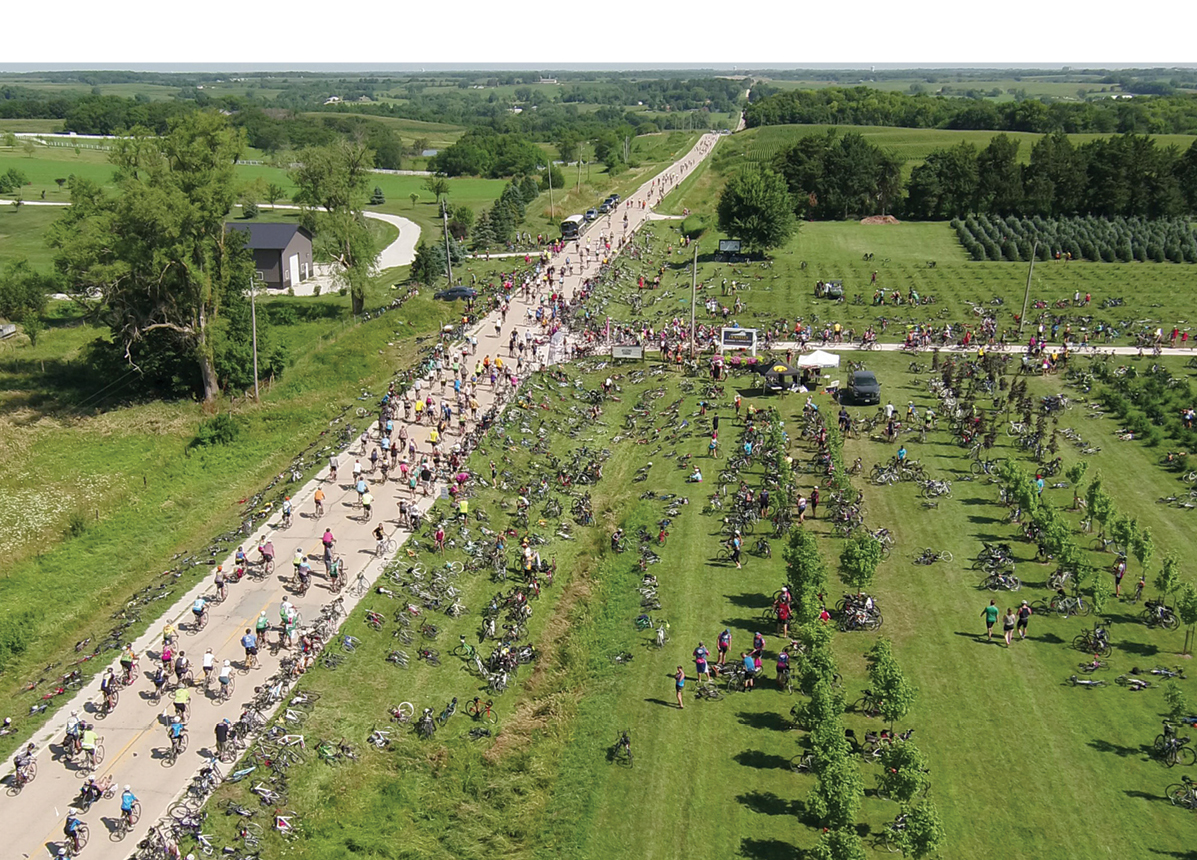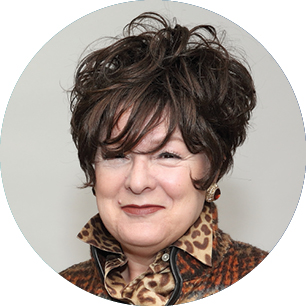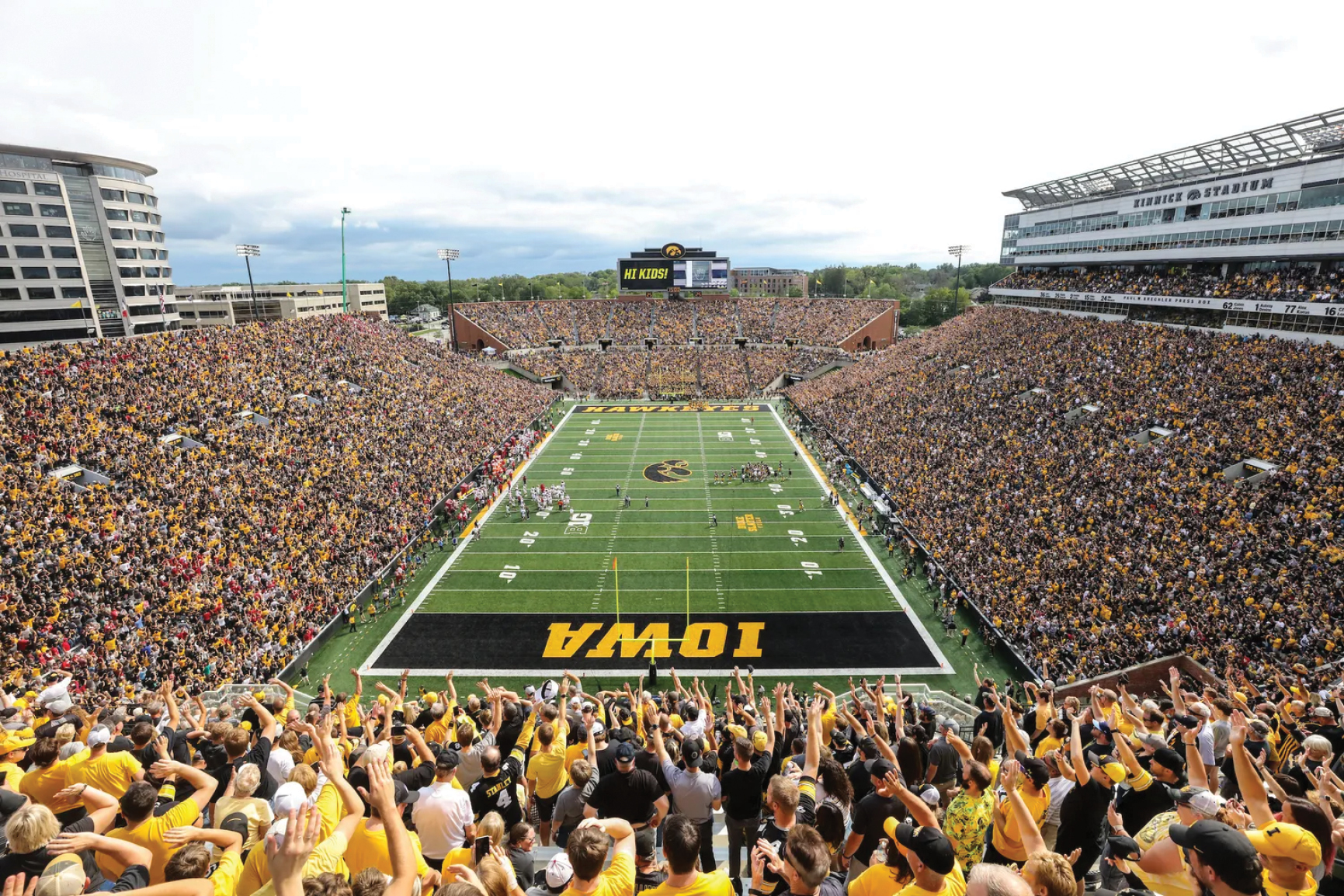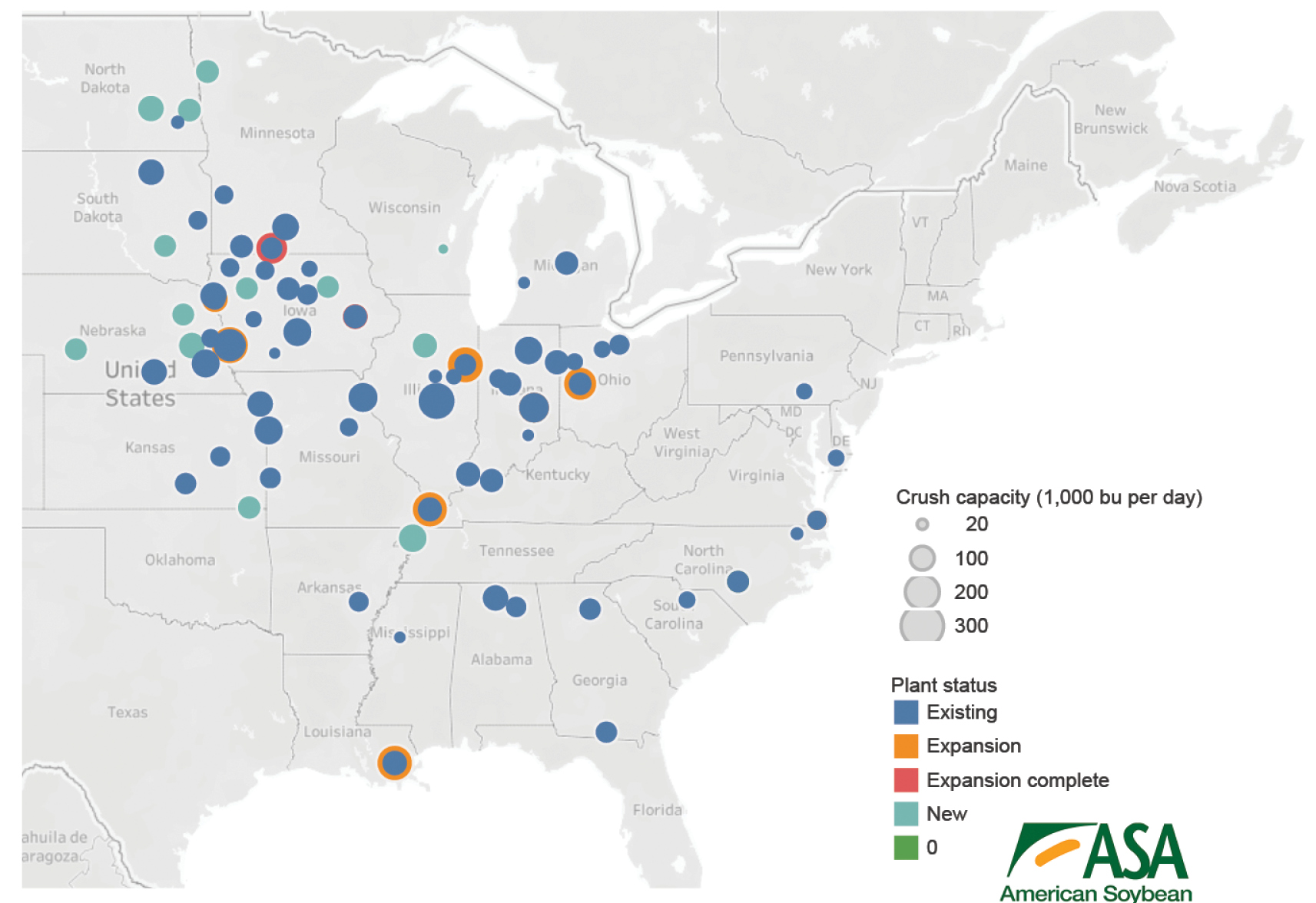This year’s 500-mile RAGBRAI (Register’s Annual Great Bicycle Ride Across Iowa) marks the 50th anniversary of the oldest, largest and longest recreational multi-day bicycle ride in the world.
The ride offers one framework for spotlighting economic development projects and trends across a state on the move economically — sort of like the original motivation for the first ride dreamed up by Des Moines Register feature writer and copy editor John Karras and columnist Don Kaul. That first year wasn’t a showcase for planning, but it’s certainly part of the well-choreographed event today, which will welcome some 20,000 riders in July. It’s part of Iowa’s vision for economic growth too. But first it’s about making people feel welcome.
Debi Durham, the longtime economic and community development professional from Sioux City who serves as director of the Iowa Economic Development Authority (IEDA) and the Iowa Finance Authority (IFA), calls RAGBRAI “Iowa hospitality on full display. It’s a gathering place. People come in from all over the world, come back year after year and develop friendships for life.”
Durham just found out her son and family are coming in this year from Long Island to ride in the event. “It’s about Iowa nice, which is so real,” she says, “the way these communities just roll out the welcome mat. You come as a guest and leave as family.”
The Short Trip From Tourism to Talent Attraction
We begin this year’s trek in Sioux City — whose metro area in March 2023 once again was the nation’s Top Tier-3 Metro and Top Tier-3 Metro Per Capita for corporate facility investment projects tracked by Site Selection over the previous calendar year. We finish in the Quad Cities community of Davenport, which riders will be happy to see after their extra-hilly week-long journey through host cities Storm Lake, Carroll, Ames, Des Moines, Tama-Toledo and Coralville.

This year’s RAGBRAI route is the sixth longest in its 50-year history and the sixth hilliest, meaning riders will welcome stops like this one to rest, refresh and recreate.
Photo of 2019 RAGBRAI ride courtesy of The Des Moines Register

Debi Durham, Director, Iowa Economic Development Authority and Iowa Finance Authority
Durham says ever since she arrived at the IEDA her team has taken a holistic approach, balancing laws and policies supporting a business-friendly tax and regulatory climate with the need to build communities that attract people for longer than a RAGBRAI overnight sleep spot.
“Iowa’s greatest challenge right now is population,” she says. “It’s all about creating places people want to live” with the right mix of housing and quality-of-life amenities, “programs that raise the standard of living for Iowans.” As American Rescue Plan dollars came to each state, she says, “Governor Kim Reynolds wanted to make sure we were not growing government with that. We are really in the mode of leaning down government, in fact.”
Among the foundational programs established was the $100 million Destination Iowa program, which has awarded funds to a plethora of projects, all characterized by public-private partnership. “Iowa has always done very well at that,” Durham says.
Destination Iowa driven by research that IEDA and its Travel Iowa department conducted during the tourism-light pandemic to ascertain whether a valuable connection exists between tourism and workforce. “When you visit a place and have a ‘wow’ experience, does it cross your mind to come live and work there? The answer was yes,” Durham says. “Did COVID-19 change the way you think about the place you call home? Seventy percent said yes. People are looking for affordability too — Iowa was just ranked the No. 1 place for affordable housing in the whole country by U.S. News and World Report.” Indeed, Iowa’s homeownership rate is among the highest in the nation at 73.8%, and the state aimed to make that even higher in 2022 when it made an historic $100 million investment to create new workforce housing.
Talent cultivation in Iowa also involves a robust workforce development system that has enabled a successful apprenticeship program with more than 1,000 occupations eligible for grants and a workforce participation rate that’s among the top five in the country. The system includes a nimble community college network whose industrial new jobs training program 260E Durham calls one of the best training incentives programs there is.
The clean hydrogen economy could be the next sector creating those valuable jobs. Gov. Reynolds in April joined the governors of Nebraska and Missouri in submitting a grant application with the U.S. Department of Energy for funding to establish the Mid-Continent Clean Hydrogen Hub (MCH2) in the tri-state region. The 2021 Infrastructure Investment and Jobs Act authorizes the spending of $8 billion on the establishment of at least four large-scale “Regional Clean Hydrogen Hubs.” A 2022 report from Ideal Energy backed by funds from the IEDA and the U.S. DOE calls Iowa “the Persian Gulf of Renewable Hydrogen” for both production and consumption. The reasons? “Iowa has abundant renewable energy resources, an existing agrichemical industry and a huge demand for hydrogen products,” the report says. “With a renewable hydrogen industry in the state, Iowa could see a $1.19 billion increase to its gross state product (GSP) by 2030 and a $6.375 billion GSP increase by 2050. Research suggests Iowa’s hydrogen industry could contribute more than 7,000 new jobs by 2030, and up to 35,000 new jobs by 2050.”
Advancing in More Ways Than One
The IEDA placemaking research showed that people also want economic vitality (i.e. job options), outdoor recreation and yes, they need to be connected the whole time, so broadband is part of the picture too.

RAGBRAI exhibits the best of Iowa and Iowans. So does the Hawkeye Wave, when University of Iowa football fans, players, coaches and everyone else in Kinnick Stadium turn their attention to pediatric patients and their families at adjacent UI Stead Family Children’s Hospital and wave at the end of every home game’s first quarter.
Photo courtesy if University of Iowa Athletics
“By 2028 we expect to have spent about $1 billion across the state on broadband,” Durham says. With a lot of the state’s manufacturing in rural areas, such infrastructure is as crucial for precision agriculture and implementation of manufacturing 4.0 as it is for taking selfies. Durham says the IEDA, again using ARPA funds, has stood up the Manufacturing 4.0 initiative since January 2021 to support implementation of 4.0 strategies, working in partnership with The Center for Industrial Research and Service (CIRAS) at Iowa State University — located in one of this year’s RAGBRAI towns, Ames.
In February, Gov. Reynolds and the IEDA announced the state will be investing an additional $2 million in the Manufacturing 4.0 Technology Investment Program to help small- to mid-size Iowa manufacturers invest in the adoption and integration of smart technologies. In the first cycle, IEDA granted over $7 million through 202 awards with project investments totaling over $31 million.
“Manufacturers are using these grants to increase productivity, train workers, improve safety, and cut costs,” said Gov. Reynolds. “We now have the opportunity to help more manufacturers invest in technology to support their workforce, promote competition, and ensure future growth.”
“We’re not doing deferred maintenance,” Durham tells me. “We’re buying equipment and technology to help you on that 4.0 journey.”
More companies are considering the journey in Iowa thanks to tax reform passed last year. “People are taking notice,” Durham says, of the measure that lowers the individual income tax rate for all Iowans to a flat 3.9% rate by 2026 (less than half of what it was in 2018, when previous reforms were signed), eliminates income tax on all retirement income starting in 2023, and overhauls Iowa’s corporate tax system with a target corporate income tax rate of 5.5% based on a trigger of $700 million per year in minimum collections. Once fully phased in, the Tax Foundation says Iowa could leap from 46th before the 2018 reforms all the way to No. 15 in its annual State Business Tax Climate Index, which would tie North Carolina for the largest improvement in the Index’s history.
Durham says the energy and bioscience sectors are robust with lead activity right now, “and the taxation is driving some of that. But some has to do with our value proposition on sustainability,” which calls for the state’s investor-owned utilities to be generating from 100% renewables by 2030. That yardstick stands at 68% today. “We’ve been on that journey for a long time,” she says. The state’s sustainability and ESG profile combines with programs like its certified site program to create a potent mix.
“ESG has taken on so much politics it didn’t need to,” she says. “The sustainability journey is something Iowa has been on for decades. Companies have goals to be carbon-neutral by 2050. Iowa can actually help you get there and stay out of all that political stuff that quite frankly gets in the way.”
And with that, it’s time to be on our way — along the RAGBRAI route across Iowa.
Sioux City
When cyclists begin their journey from Sioux City, they’ll be launched from a tri-state region that’s a perennial leader in Site Selection’s annual tallies of corporate facility projects. Last year investors in just the Iowa portion of the region included Cargill, MidAmerican Energy, Thompson Equipment Co. and Cold-Link Logistics.
Up on Prospect Hill downtown, you’ll find the brick façade of Stone Bru Coffee Shop, another growing business with aims to grow more. Brad Lepper, founding partner and owner, says others wanting to grow are waking up to his city’s potential.
“Des Moines and Iowa City are running out of historic buildings,” he says. “Those developers are now looking here.”
They would do well to arrange a redevelopment tour by Lepper, whose company does a lot more than lattés. I met Lepper and Stone Bru Wholesale Director Adrian Kolbo in March at the company’s HQ, wholesale, roasting, events, equipment M&R, office and retail operations, located in a 101-year-old building the company moved into last year.
“I’m an Iowa farm kid,” says Lepper, whose background includes traveling with his family performing gospel music. That’s a perfect background for coffee, he says. “Coffee is left- and right-brained, mechanical and artistic.”
Lepper has a creative vision for his company’s historic neighborhood, which includes the former site of coffee roaster Empire Mills. That enterprise furnished coffee to much of the Midwest more than a century ago. But the future is near too. Lepper’s vision is to clean up a four- to six-block area on Prospect hill and then facilitate development.
He’s already doing that within his own establishment, having refurbished an open, brick-walled space now occupied by digital marketing agency Antidote 71, which signed a 10-year lease in 2022.
“Prospect Hill will be an indicator to people driving by on I-29 that Sioux City is a place to invest,” says Kolbo. Some people already have. He says a downtown area that had as few as 54 market-rate apartments in 2015 now has between 400 and 500 with waiting lists.
Storm Lake
Among the largest projects to land in Buena Vista County in recent years is the $350 million soybean processing plant from Platinum Crush announced in September 2021 in Alta, Iowa, on the northwest outskirts of Storm Lake.
January 2023 analysis by the American Soybean Association documented 23 soybean crushing plant expansions (13 of them new) announced in recent years, adding about 750 million bushels per year in crush capacity.

Iowa has the lion’s share of a crush of soybean crushing facility expansions and locations over recent years, including a new one from Platinum Crush in Alta, Iowa, on the outskirts of Storm Lake.
Source: Gordon Denny and American Soybean Association
“Iowa has the highest soybean crush capacity of any state with more than 1.3 million bushels per day of nameplate capacity (approximately 420 million bushels per year in practical capacity),” wrote ASA economist Scott Gerlt. “Realized announcements would add about another 340,000 bushels per day in nameplate capacity.”
With an enrollment of just under 2,000 students, Buena Vista University in Storm Lake says over 68% of Storm Lake campus graduates and 89% of offsite graduates stay in Iowa to work and contribute to their professions and their communities.
Carroll
As the Carroll County Growth Partnership (CCGP) explains, Carroll and its eponymous county are known as the hub of western Iowa, only 90 minutes from Des Moines. Fittingly for a community positioned at the intersection of U.S. Highways 30 & 71, Carroll is home to the headquarters of motorcoach company Windstar Lines, whose fleet in 2017 set a new record by traveling 5 million miles.
You don’t have to go that far to find sites in the area’s target industries of advanced manufacturing, ag and ag-tech, data and IT, and food processing. Or to find a place to set up your own shop. This year the Partnership launched Micro-Facade Grant and Jump-Start Accelerator Grant programs to incentivize new business start-ups, business expansions, and facade improvements to downtowns all across Carroll County.
But bigger companies are welcome too: Among the county’s major employers in Carroll and in other communites such as Pella Corporation, wholesale food services company Farner-Bocken, Smithfield Foods, United Technologies Corp. Aerospace Systems (Collins Aerospace) and American Home Shield.
Is the area ready for RAGBRAI? “You’ll have a barrel of fun” on July 24, 2023, the community promises. Campers will bed down at Carroll High School and on the Carroll campus of Des Moines Area Community College, which just expanded last year with a new commons area and two new labs for welding and industrial tech.
Ames
Ames National Laboratory is the smallest national lab in size — only eight acres and 12 buildings — but carries tremendous weight in the field of materials science. The lab has a $60 million budget, 473 employees and dozens of students on board at its location on the campus of Iowa State University — the only one of the 17 DOE national labs located directly on a research university campus. Among those 17, Ames also has historically ranked at or near the top in royalty income from inventions.
The university itself — the nation’s first land grant university —has the largest undergraduate enrollment of any campus in Iowa and includes students from all 50 states and 112 other countries.
Iowa State University Research Park is a 500-plus-acre development serving more than 100 tenant companies and is home to such corporate operations as the John Deere Technology Innovation Center.
The newest project at the research park is the Alliant Energy Agriculture Innovation Lab. Projected for completion by fall 2024, the lab will provide more than 85,000 sq. ft. for ISU’s College of Agriculture and Life Science’s Digital Ag Innovation team as well as agriculture-based business tenants “to access technology, research, development and each other for innovation opportunities primarily focused on digital and precision agriculture,” the university says.
Des Moines
Iowa ranks No. 1 in the U.S. in insurance industry output as a percent of GDP, and the state’s 1% insurance premium tax is one of the lowest rates in the nation. The state is home to more than 7,000 finance and insurance companies, 183 of which are headquartered there. And across financial services the state has the second highest concentration of insurance workers in the U.S., the highest concentration of commercial banking employees in the U.S., the second highest concentration of actuaries in the U.S., and the third highest concentration of new accounts clerks in the U.S.
If Iowa is the capital of the global insurance industry, then Des Moines is the capitol building itself. That’s why 600 insurance industry leaders and regulators from around the world gathered there this spring for the Global Insurance Symposium. And it’s why the city is home to the Global Insurance Accelerator, the world’s first business accelerator focused on insurtech that’s home to a mentor-driven program that has attracted national and international participation.
Among the innovative employers is Open Loop, a telehealth company that occupies the former Bank of America building downtown. Mike Swesey, executive vice president of the Des Moines Partnership, says the company, founded by a resident of Pella 30 miles away, chose the location because of workforce access and housing, and promotes employees living downtown, even providing a row of e-scooters for them to use. It’s a trend the Partnership has encouraged too, with aggressive incentive for housing development. Current projects under way will see another 5,000 residents living downtown. “We’ll have housing for the foreseeable future,” Swesey says. When those residents aren’t working, a blooming downtown scene is there to enjoy, as is a new professional soccer stadium.
“The downtown has gone through a real renaissance here,” says IEDA Marketing and Communications Team Lead Kanan Kappelman. “I’m originally from the New Jersey/New York area. I moved to Japan for three years after going to Penn State, met my husband there, and he brought me here because he’s from Iowa, about 25 years ago. It was a big change for me, but I’ve grown to like it so much, I could never think of relocating to the East Coast.”
Tama-Toledo
A town of just under 2,400, Toledo was home to the original “Butter Cow Lady” from the Iowa State Fair, Norma (Duffy) Lyon. It’s the county seat of Tama County, which has welcomed a $562 million investment from cattle processor Iowa Premium in recent years as well as a $100 million expansion from National Beef Packing Co.
“This project will increase our capacity to produce products that are in high demand by our customers worldwide and will provide an expanded market for the Iowa family farmers who supply us with premium Angus cattle,” said Tim Klein, president and CEO of Kansas City–based National Beef, in a 2021 press release. The site already employed around 850 people, and expected to create several hundred more jobs in the region with the expansion.
Coralville
In February, one of three companies approved by the IEDA for assistance in the first round of innovation awards funded through the U.S. Department of Treasury’s State Small Business Credit Initiative (SSBCI) was Coralville-based IntelliSee, which says it creates “Smarter Surveillance for a Safer World” by autonomously monitoring an organization’s existing surveillance cameras 24/7/365 with AI that detects threats, risks and hazards. IntelliSee’s AI currently detects drawn guns, slipping hazards, fallen persons, trespassing, loitering, vehicles and other risks with additional detections planned for future release.
IntelliSee launched its beta version in 2020, leveraging $100,000 from IEDA’s Demonstration Fund. The platform is currently installed in K-12 school districts, community colleges, universities, hospitals, retail stores and other organizations. The company was awarded a $500,000 Innovation Acceleration Propel loan for product refinement and key personnel.
“From day one, the State of Iowa has been very supportive of our mission, and we’re thankful for the state’s continued support and confidence in us,” said IntelliSee CEO Scott Keplinger. “This funding will help us protect more organizations and their people, in Iowa and throughout the country, while creating high-tech jobs here at home.”
Davenport
This community — largest city and economic engine of the bi-state Quad-Cities area — in recent months has welcomed new projects from Amazon, Continental Cement, Cobham Mission Systems Orchard Park, Sterilite Corp. and Divvymed, among others. It’s also home to, among other company operations, John Deere & Company’s Davenport Works, one of a plethora of advanced manufacturers in the region and across the state that contribute $33 billion annually to the state’s economy and represent 18.2% of Iowa’s GDP.
Other recent expansions in the area have come from Kraft Heinz, Fair Oaks Farms and others in food manufacturing, the second largest subsector of manufacturing in Iowa. Iowa has the third highest concentration of food manufacturing employees in the U.S. Twenty-nine of the largest 100 food manufacturers have Iowa operations, including companies such as Hormel, and General Mills.
Already at the heart of so much essential industry, Davenport is also at the heart of a logistics region featuring major rail, river and highway connections. Two years ago, not far away, a new I-74 bridge over the Mississippi River was dedicated after years of work and stellar cooperation between the state departments of transportation in Iowa and Illinois. Marking the occasion were banners that said the same thing RAGBRAI riders will feel when they get to this side of the state: “We Made It!”
Here’s to all that the people, companies and leaders in Iowa are making for the future. Saddle up.

